ISSN 2410-5708 / e-ISSN 2313-7215
Year 8 | No. 23 | p. 179 - 196 | October 2019 - January 2020
© Copyright (2020). National Autonomous University of Nicaragua, Managua.
This document is under a Creative Commons
Attribution-NonCommercial-NoDerivs 4.0 International licence.
Requirement analysis and management information system development of the available varieties of georeferenced basic grains, in the Department of Carazo (SIGITEC), in the period 2007-2015
https://doi.org/10.5377/torreon.v8i23.9535
Submitted on December 02nd, 2019 / Accepted on January 28th, 2020
Ing. Álvaro Antonio Mejía Quiroz
Teaching researcher
UNAN-Managua, FAREM-Carazo
Keywords: varieties of basic grains, information systems, biophysical parameters, farmers, geographical data.
Abstract
It is presented the creation of a management information system1 of the available varieties of georeferenced basic grains in Carazo released by the Nicaraguan Institute of Agricultural Technology (INTA), between 2007 and 2015, which contributes greatly to the management of information on these. Developed by the Research and Technological Development Unit of the Facultad Regional Multidisciplinaria de Carazo (FAREM-Carazo), with support from the Research Funds (FPI) of UNAN-Managua; that allows entering information of the characteristics, geographic location, and analysis of the suitability of the plots concerning the varieties of basic grains. The investigation resulted in: the analysis of the system requirements, the alternatives for the digitization of the temperature, rainfall, altitude and soil type maps of the Carazo department, also the layout of the maps, as well as the choice of an alternative technology analysis, design, development, and implementation with solidly structured components. This product allows the efficient management of varieties and real-time analysis of the biophysical conditions of the plots for the determination of which varieties of basic grains are adaptable to them, making use of the C# Programming Language and the ArcGis Online platform for Map management and administration automatically.
Introduction
Agriculture is one of the main items, if not the most important, that strengthens Nicaragua’s economy, according to The World Bank, (2019), it grew 4.7 and 4.5 percent in 2016 and 2017, respectively, but due to the social and political problems that the country experienced in April 2018, the economy contracted 3.8 percent in 2018 and contracted to -5 percent in 2019, according to the latest forecasts.
This situation provides a scenario for Nicaragua, as a condition full of opportunities to establish proposals that impact forcefully and transcendentally in favor of agriculture, the environment, and the Nicaraguan economy, making appropriate use of communication and information technologies (TIC) in projects that are executed from the academy in favor of society.
In the strategy of the Inter-American Development Bank, (2012), three sectors are proposed in the areas of transversal action: (i) reduction of vulnerability, adaptation and mitigation of climate change, (ii) gender and (iii) diversity. Taking into account the first sector, it is necessary to recognize that the technologies of basic grain varieties are adapted to very diverse and documented biophysical conditions, but INTA does not have a system open to the population that allows it to systematize all varieties of basic grains (rice, corn, beans, and sorghum) and give producers an innovative tool that speeds up the processes of seed acquisition or real-time analysis of their plots, this does not detract from the great work that technicians do with each delegation with the farmers in the communities they serve.
During the last decade, Information and Communication Technology (ICT), has become a solution to improve agricultural production. This trend can be reflected in the multiple software applications that provide services to reduce the effects caused by diseases and pests on crops, or in real-time monitoring of climatic conditions and water quality parameters used for production. Management activities, decision making, and complex event management are cornerstones assumed by the ICT solutions applied to agriculture.
Angelov, Iglesias, & Corrales, (2017) and Corrales, Angelov, & Iglesias, (2018), have systematized international conferences in Colombia where emerging problems and new ICT solutions were analyzed to address the effects of climate change and climate variability in the sector, proposing common strategies and guidelines to incorporate risk management and adaptation to climate change. Topics such as smart agriculture, disease or pest prediction systems, water efficiency, climate and its effects on crop production, land cover modeling for forest and crop systems, remote sensing for production and crop management, the integration of meteorological data for agriculture were covered by the authors. The conference was organized by the Interinstitutional Network for Climate Change and Food Security of Colombia-RICCLISA, COLCIENCIAS, Universidad del Cauca, Colombia (Telematics Engineering Group) and the Carlos III University of Madrid, Spain (CAOS research group), and technically sponsored by Spring.
Farmers and institutions, both public and private, related to the issue of agriculture, know very little about the types of innovative technologies that can be used in agriculture, this causes a waste of them, to this we add that many producers still use agricultural practices not friendly to the environment, which directly affect the climate and accelerated degradation of soils.
Another aspect to take into account is the failure to take advantage of the knowledge base that is generated in the Public Universities of the country promptly, despite this situation links are being made and presentation of advances in the subject in Nicaragua. The Nicaraguan Institute of Agricultural Technology (INTA) is promoting the National Innovation Award for farmers, farmers associations, teachers and research students, a space that can be used to publicize the progress of the study proposal of this research work.
In Nicaragua, there is a considerable amount of agricultural technologies. The Nicaraguan Institute of Agricultural Technology, (2015), mentions that “in the country, there are 284 technologies of which 231 have been generated by INTA and 53 by the different universities in the agricultural sector.” In the same catalog, according to studies done in the field, there are “117 technologies applicable to the production of the country” and of these 117 technologies “68 varieties of seeds, 21 of bio-inputs, 9 agricultural implements, 11 systems of irrigation and 7 post-harvest and storage”.
The Nicaraguan Institute of Agricultural Technology, (2019), at the web address http://www.inta.gob.ni/agricultura-inteligente, presents all the necessary recommendations for the cultivation of basic grains, vegetables, and legumes, roots and tubers, livestock, industrial and export, musaceous, diverse and export, fruit and cucurbits, for each one of the municipalities of the country, but it does not do it dynamically or automatically and presents the optimal conditions for each of the mentioned areas for the areas specified in the country.
With the development of the first stage of this research, the result is the creation of a novel product, being this one more of those that have been developed by the Research and Technological Development Unit (UIDT) in recent years, specifically with the research line that belongs to the category of Information Systems for Decision Making, particularly in the field of application of Varieties Technologies in Basic Grains (beans, rice, sorghum, and corn), adding a very important component such as the geographic data, which according to Pérez Navarro, (2011), “are the digital representation of entities, objects or phenomena that occur on or near the surface of the Earth.” (p. 143).
In this sense, the UNAN-Managua FAREM-Carazo strengthens the research and extension functions with the farmers and the INTA Institute of the Carazo department. In this context, the Government of Reconciliation and National Unity, (2017), in the axes of the National Human Development Program (PNDH, as in Spanish), mentions that “the characteristics of this intervention are defined by an assistance that integrates researchers, extensionists, and producers with direct work on farms, with recognition of both the potential of the area and the local culture of rural families”, this warns that educational institutions are obliged to give real solutions to the problems of the country where they can influence positively.
Methodology
For the study, different methodologies were applied that helped in the different phases of the research process, from interviews with specialists and farmers to obtain the information that once processed resulted in the definition of the requirements and the scope and limitations of the system, to the use of methodologies proper to the analysis, design, and implementation of the system to generate a reliable product that meets the requirements of the Object-Oriented Programming methodology and the use of Geographic Information Systems, which according to (Corrales et al. , 2018), is defined as, “the organized actions with which people measure aspects of geographic phenomena and processes to emphasize spatial issues, entities, and relationships. It is worth mentioning that they operate under these representations, discover new relationships by integrating different sources and transform these representations.”
The process for the development of the system consisted of four general stages:
1. The first was based on the determination of the terms of reference to determine each of the elements necessary for the next two stages, and the activities that were carried out were the following: group interview with teachers of the Facultad de Recursos Naturales (FARENA) of the Universidad Nacional Agraria (UNA), group interview with the departmental delegate of INTA and the 8 technicians working in the department of Carazo and a focus group with a group of farmers fr El Abra community, in the municipality of La Conquista.
2. The second one consisted of the development of the geo-referenced databases of the municipalities of Carazo that, for their implementation in the information system, were executed with the digitalization of the maps in the ArcGis 10.3 program and then the accommodation in a service ArcGis Online website. The thematic maps that were housed in this platform are precipitation, elevation, temperature and soil types.
3. The third stage consisted of the implementation of the relational database of basic grain technologies, data that were obtained in the first stage, in the department of Carazo using Microsoft SQL Server, Visual C# and Entity Framework that according to MicroSoft, (2019), allows “developers to work with data in the form of domain-specific objects and properties such as clients and client addresses without having to worry about the underlying database tables and columns where this data is stored”, being this combination a programming tool, always taking into account the principles and standards of web-forms, where the Unified Model Language (UML) was used, based on the Object-Oriented Programming Paradigm (OOP) that focuses on the importance of processes in the proper design of data structures and on the other hand promotes effective software reuse and facilitates scaling Software ability based on new context demands.
4. The fourth stage consisted of communicating the maps hosted in ArcGis Online, with the C# Programming Language and linking with the Microsoft SQL Server database manager using JavaScript, for this a web service was configured that allowed to consume in Real-time hosted map information.
Microsoft Project 2016 was used to prepare the schedules of activities carried out, both in the information-gathering phase and in the system analysis, design, and programming stage.
The ArgoUML tool was used to elaborate on the different diagrams that the UML paradigm uses to graphically represent the different processes that the application performs during its operation. For the design of interfaces and the storage of the information, the Visual Studio 2017 and 2019 development environment was used in its final version, using the Telerik controls, and the SQL Server 2018 Database Manager.
Results
One of the results of the study was, the assessment regarding the technical feasibility for the development of the system in terms of one of the aspects of the requirements, taking into account the deadline for development, the level of knowledge in development platforms Proposals, analysis of the application and investment in equipment for the development and hosting of the system took into account the following criteria:
Table 1: Software that was taken into account for technical feasibility.
|
SOFTWARE FOR DEVELOPMENT |
|
|
IDE Development |
Visual Studio Community 2017 and 2019 |
|
Graphic Design |
Gimp 2.8 |
|
UML Diagramming |
UML Argo |
|
Programming Language |
C# |
|
Client-side language |
JavaScript |
|
Office automation |
Microsoft Office 2016 (already licensed) |
|
Environment for Web publication |
IIS Express |
|
Online Map Hosting Platform |
ArcGis (with the free version of 50 monthly credits) |
The interviews that were applied to both UNA teachers and INTA Carazo technicians gave us the following results, to establish the following information on the thematic maps and the characteristics of the basic grain varieties.
As for the information on the thematic maps, it was necessary to digitize: precipitation, elevation, temperature, and soil types, it should be noted that the soil pH and humidity information are necessary but there are no maps, for this reason, these parameters are Enter manually.
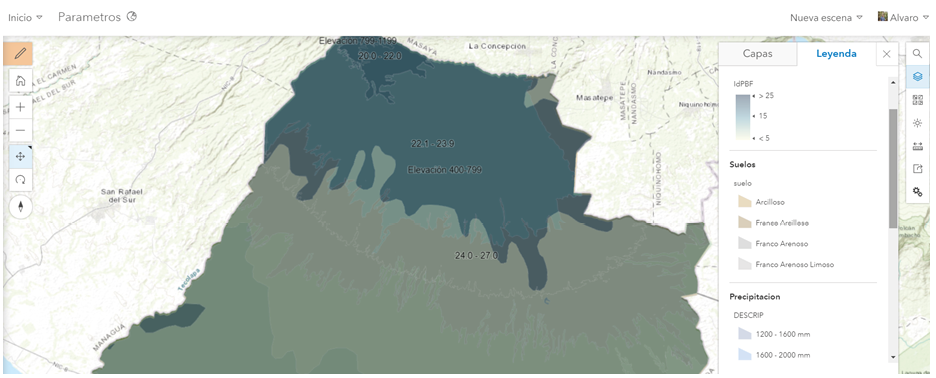
Figure 1. Thematic maps hosted in ArcGIS Online.

Figure 2. Values to parameterize each biophysical element for the maps.
For the types of soils in Carazo the types were obtained: clay, clay loam, sandy loam, silty sandy loam. For rainfall, there are three categories of stories with values of mm: 800-1200, 1200-1600, 1600-2000. The temperature range is Celsius: 20.00º-22.00º, 22.1º-23.9º, 24.0º-27.0º and greater than 27º and finally the elevation values being in ranges of 0 masl, 0-399mnsm, 400-799 masl and 799-1199 masl.
The information that was necessary for the basic grain varieties based on the interviews for each variety is as follows:
Table 2: Information needed for the relational database.
|
Qualitative |
Quantitative |
|
Date |
Country |
|
Year of the release of the variety |
Department |
|
Plant size (centimeters) |
Municipality |
|
Cob insert height |
INIA |
|
Height insert sheath |
Investigator |
|
Panning ecxsertion length |
|
|
Panicle ecxsertion length |
Identification card |
|
Potential yield (Kg/Ha) |
Item |
|
Cooking time |
Variety Name |
|
Cultivated area (ha) |
Synonyms of the variety |
|
Production volume (Ton) |
Institutions responsible for the release |
|
Average yield (Ton / Ha) |
Photos of the plants |
|
Average green matter yield (Ton / Ha) |
Name of parents |
|
Average dry matter yield (Ton / Ha) |
Origin of the Parents |
|
Average spike yield (Ton / Ha) |
Genetic Characteristics |
|
Average Fiber Performance (Ton / Ha) |
Free Pollination |
|
Estimation of the degree of adoption (%) |
Simple hybrid |
|
Latitude and longitude (projected coordinates in UTM) |
Double hybrid |
|
Amount of genetic seed (Kg) |
Triple hybrid |
|
Basic seed quantity (Kg) |
Other |
|
Registered seed quantity (Kg) |
Growth habit |
|
Amount of certified seed (Kg) |
Grain color |
|
Amount of seed from another category (Kg). |
Tumbling ability |
|
|
Adaptation to grounds with limitations |
|
|
Pathogen tolerance |
|
|
Times of sowing year |
|
|
Protein quality |
|
|
Biofortified |
|
|
Companies that produce the variety, distributor |
|
|
Adaptability to altitude ranges |
|
|
Adaptability to soil types |
|
|
Adaptability to rainfall |
|
|
Adaptability to temperature ranges |
|
|
Adaptability to moisture percentages |
|
|
Adaptability to soil pH |
Based on this information the data could be obtained.
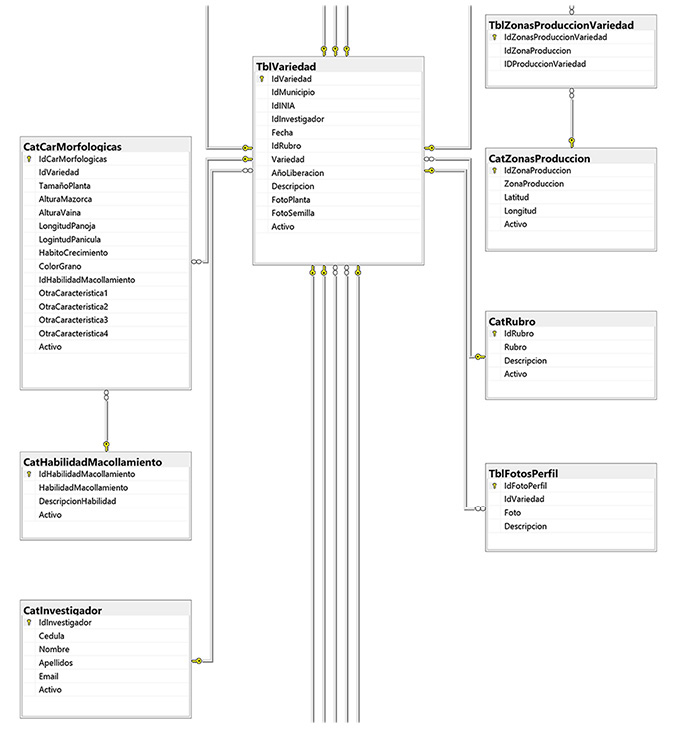
Figure 3. For the normalized relational database that was obtained from the analysis.
Once having each of the conceptual components of the system, we proceeded to create the modules, which allowed operation in a Web environment. Next, the main interfaces of the application that are part of the study result are shown.
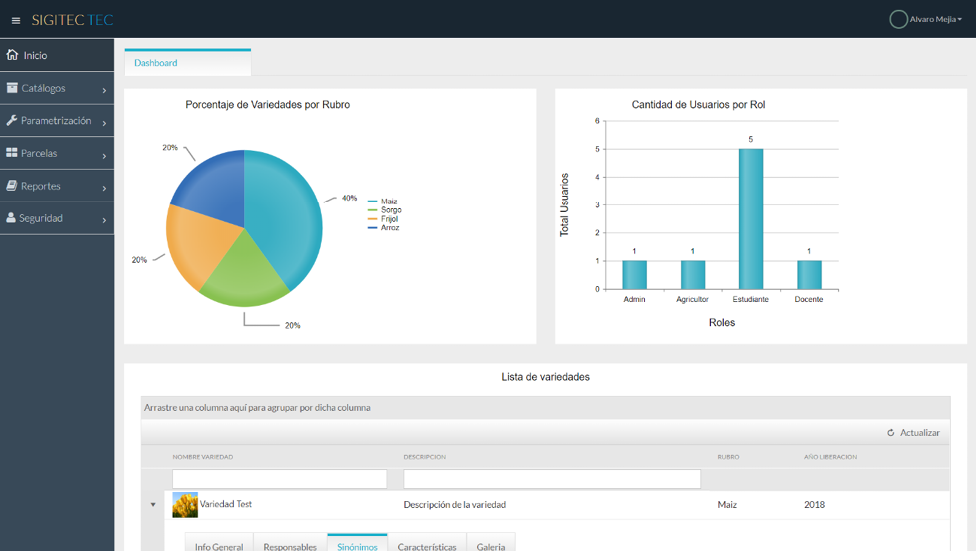
Figure 4. Main Administration of the System.
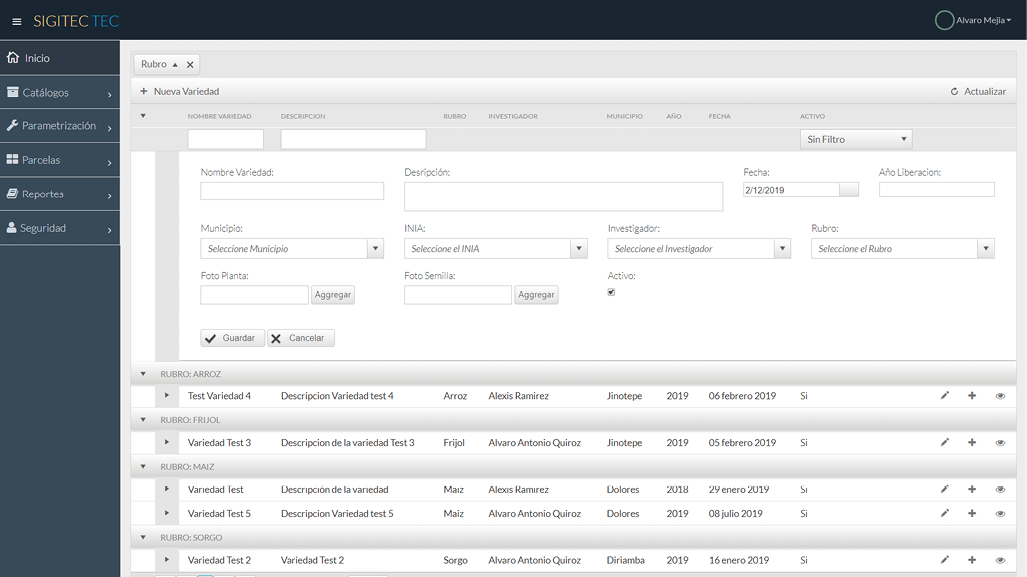
Figure 5. Variety Management.
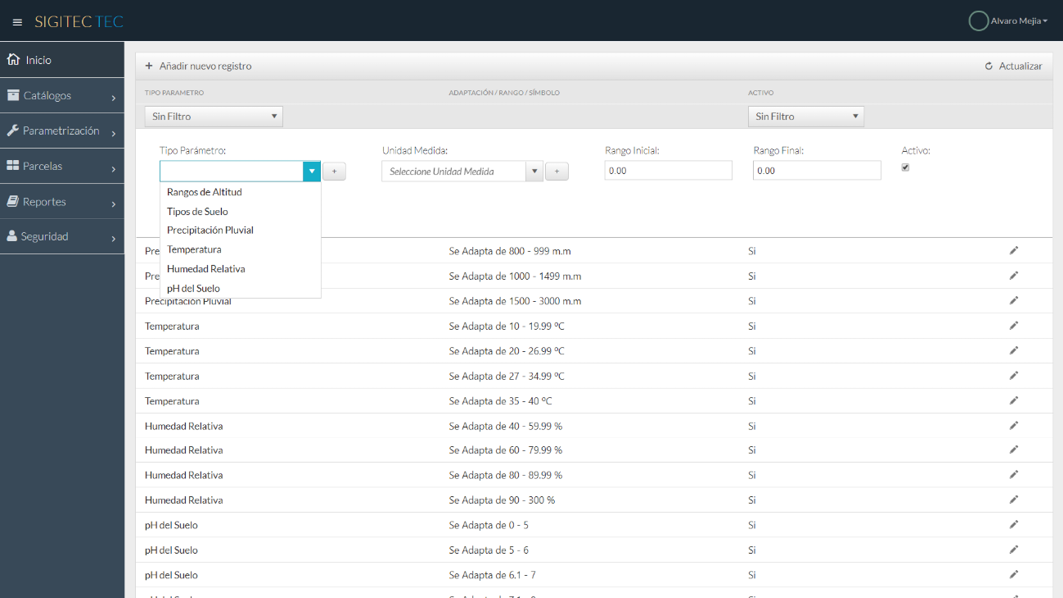
Figure 6. Administration of each parameter that may exist for the adaptability of the varieties.
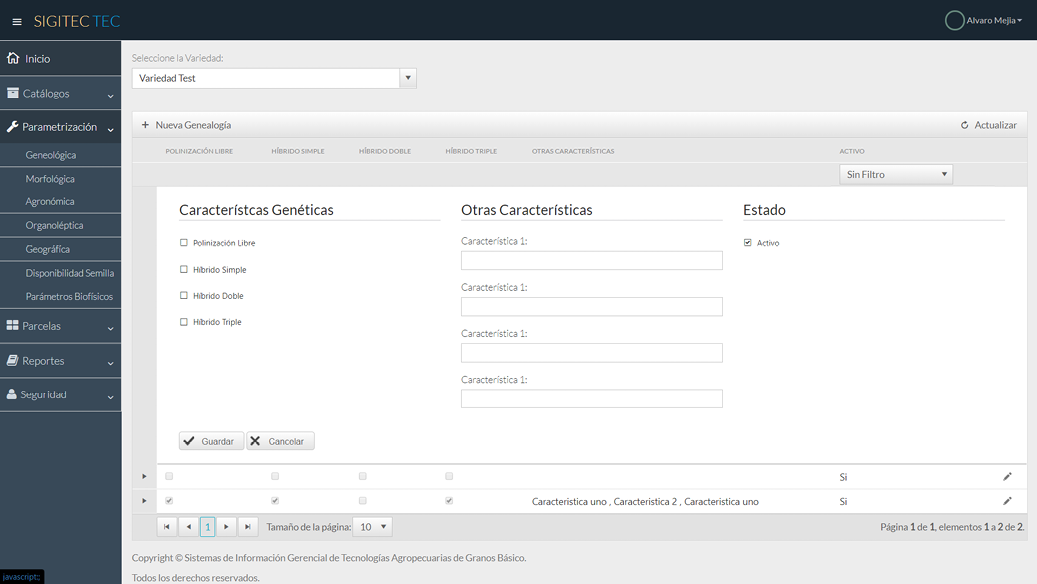
Figure 7. Administration of each variety and its characteristics.
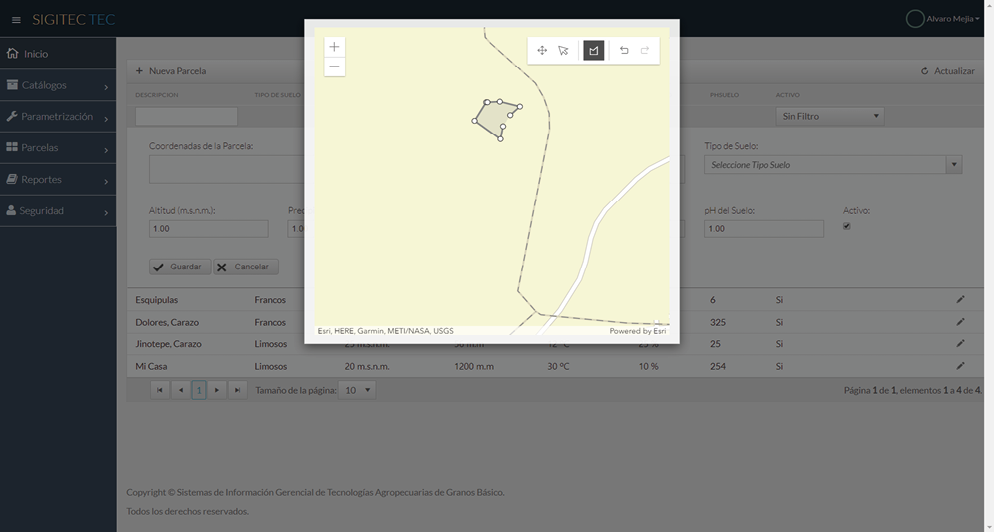
Figure 8. Administration of each plot for its corresponding analysis.
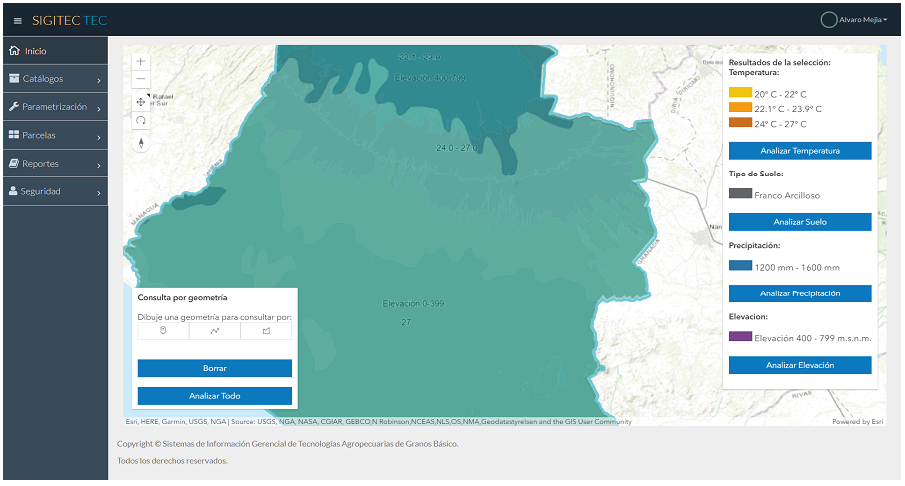
Figure 9. Parcel analysis, communication with the maps hosted in ArcGis Online.
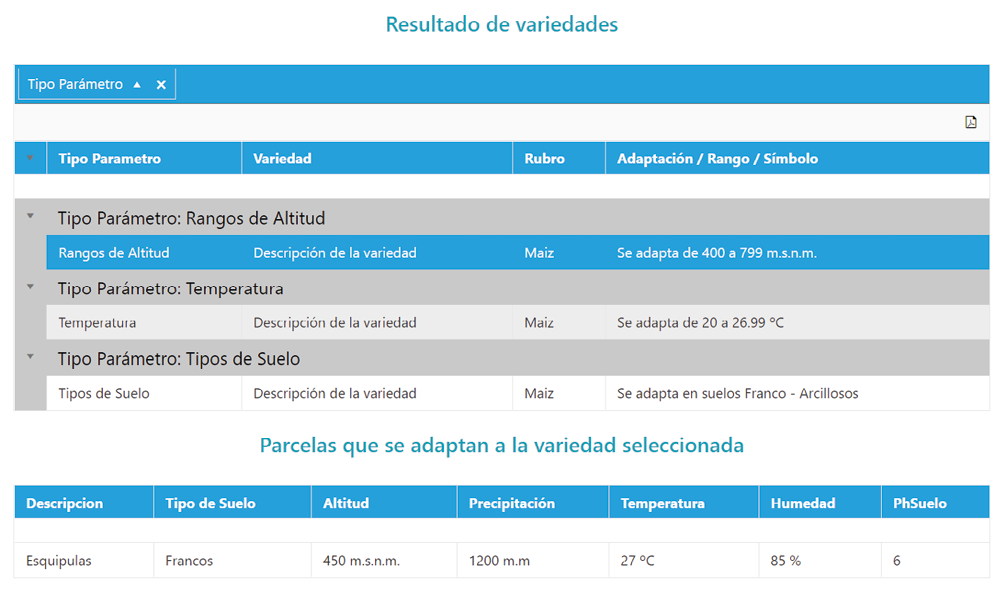
Figure 10. Analysis result.
Discussion
For Oliveros, Danyans, & Mastropietro, (2014), Web applications require new approaches to requirements engineering, which can answer capable of adjusting to a changing, large and open community with navigability knowledge, regarding the results of the In the previous chapter, we have as a starting point, for the Development process, the Pre-Design and Implementation Analysis phase, which constitute in themselves investigative activities, since with them the most relevant data that were collected, processed and analyzed allowed the establishment of the scopes and limitations which were carried out with: professors from the National University Addía (UNA), technicians from the INTA of the Department of Carazo and a group of 8 producers from the Abra community that make up a seed bank of rice in the Municipality of La Conquista, all this information was used for the generation of the database.
In this sense the necessary information that was collected were the following:
For the general information of each variety: Data of the person investigating the technology, Item and the name of the Variety, Common name or synonyms of said variety, Institutions responsible for the selection of the material and release as technology, in addition to the year in which it was released, Photographs of the plant, of the seed and the profile of said plant (either Mazorcas, Spikes, Pods, Grains, Planting)
Specific genetic or genealogical characteristics of Progenitor of the Variety and Origin of the Progenitor, Specific characteristics of the genetics of the variety (double, triple hybrid, etc.), Other important characteristics.
Morphological characteristics of the variety such as Plant size, Height of ear insertion, Growth Habits, Grain Color, Other important characteristics specified on the ballot of each variety.
Organoleptic characteristics: Cooking time, Protein quality (balance of essential amino acids), If the variety is biofortified.
Seed availability Genetic, basic, registered, certified and other categories: Quantification of seeds of selected categories produced by the INIAS (INTA agricultural research institutes in this case) and private or public companies that produce the seed of the variety, Description of the volumes of seeds present in the market and their distributors.
Morphological characteristics of the variety such as Plant size, Height of ear insertion, Growth Habits, Grain Color, Other important characteristics specified on the ballot of each variety.
Agronomic Characteristics of the Variety: Potential yield, Adaptation to different soils with limitations (saline soils, acid soils, poorly drained, low nitrogen, etc.), Tolerance or resistance to pathogens (fungi, viruses, bacteria, microplasmas, etc.) and insects and pests, sowing times of preferences.
Biophysical parameters to which the variety adapts: Altitude ranges above sea level (masl), Soil types (free, silty, clayey, sandy and the derivations of each of them), Rainfall (mm of rain falls over an area), Temperatures (in C°), Relative Humidity (%), soil pH.
The system allows to store: Amount of Hectares cultivated of a variety, Biophysical capacity for the production of a variety, Distribution by geographical area in the department, Cultivated Areas and geographical distribution in the Department of Carazo, Areas in hectares or apples of cultivation in the department, A map with the areas where the crops of this variety exist, with the corresponding geographical distribution, for this each survey of the varieties must have the geographical coordinates in the official georeferencing system of the country, Estimation of the adoption of the material in the department, Production volume of the variety for each zone, Yield for each item in the cultivated areas, Estimation of the degree of adoption of the grain in the department.
With the aforementioned, we proceeded to the definition of software technology and the methodology to be used, and for this, as mentioned by Molina R., Zea O., Contento S., & García Z., (2018), When comparing methodologies such as SOHDM, OOHDM, WSDM, WAE, UWE, and IWEB, from the analysis of the information and comparison in the frame of development of their research, it was obtained as results that the OOHDM methodology is the one that complies with almost all the features for the web application development process. For the use of this methodology, the UML diagram was used, which represented the entities and relationships and interactions between them.
To assess the feasibility and feasibility of software development, the provisions of Oliveros et al., (2014) were taken into account, in which they define Web applications as technology that requires special methods and tools for their use, in addition to technical knowledge and scientists for its development, for this the proposal was analyzed based on the knowledge of the language, the link with C# and the ArcGis Online platform as shown in Table 1.
About the development and the technology used for the communication of the database, there was the advantage of the documentation about the online map consumption service that can be done from C# to ArcGis Online, for this we proceeded to encode and consume the web service that allowed this communication between the SQL Server database and the Maps.
The following figures show the software life cycle used and the general communication diagram.
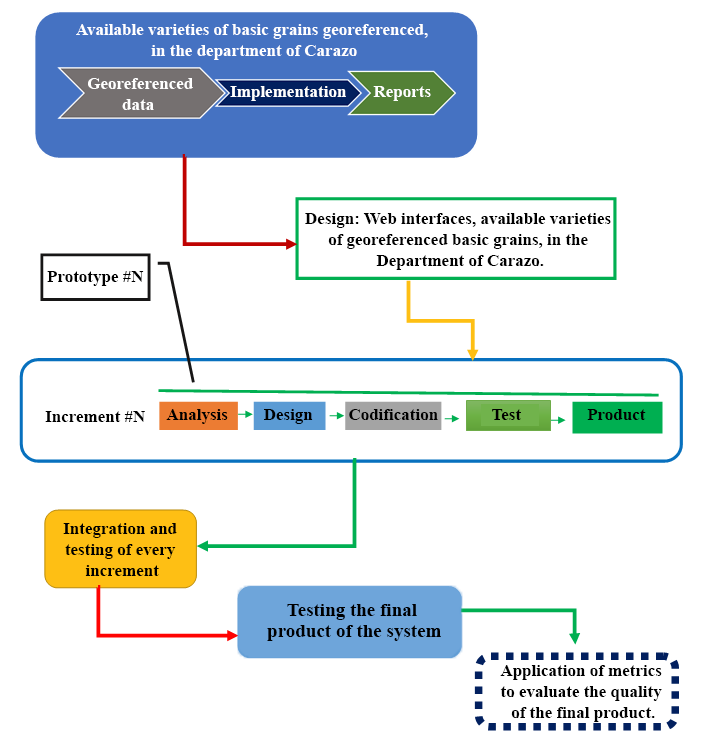
Figure 11. Life cycle of system development.
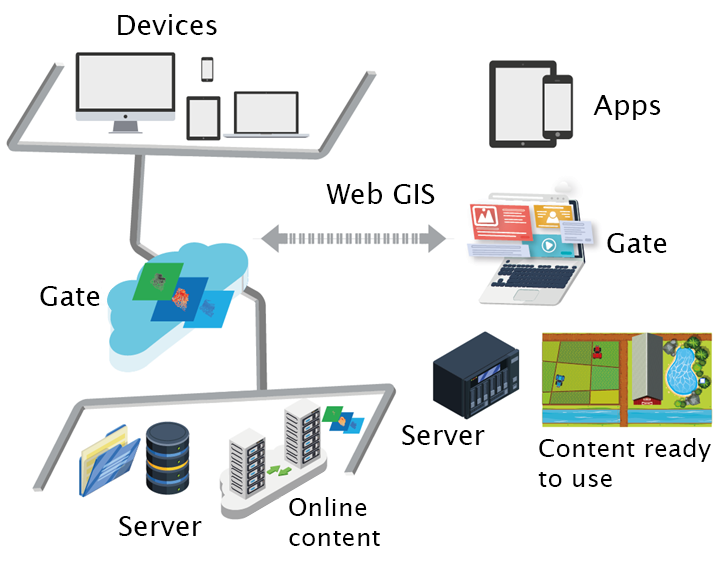
Figure 12. Diagram of the communication system server and map server.
Conclusions
After having conducted the interviews with the teachers of the UNA, INTA-Carazo Technicians, and farmers, in which they discussed how the system modules, entrances, and exits that it should obtain and show respectively should be structured. It was obtained as the main results, the definition of the scope and limitations of the system, which was taken as a starting point to start with the definition of the web system requirements.
Under the above and following the definition of the specific objectives set, the technical feasibility study was carried out taking into account the benefits of the selected technologies. This decision was taken taking into account the experiences in Geographic Information Systems and the selected programming language.
With the information collected and the development platform chosen, the analysis and design stage of the Basic Grain Technology Management System was continued, for which the layout was carried out using the UML paradigm and the OOHDM methodology (this being the better evaluated according to Molina Ríos et al., (2018)), for the design, in terms of the conceptual, navigational and interfaces, to create an intuitive and very useful product.
The use of the ArcGis Online platform gave the necessary guidelines for communication between the database developed in SQL Server 2018 and the thematic maps that were prepared to be consumed in real-time and to determine the adaptability of basic grain varieties at biophysical conditions established in the requirements engineering of the first stage.
Notas al pie
1. Research: Management information system of the available varieties of georeferenced basic grains, in the Department of Carazo (SIGITEC), in the period 2007-2015, financed by the FPI funds of the UNAN-Managua, of the Master's Degree in Scientific Research Methods MEDINV Second Cohort. Research Line: Technologies, Innovation, and Renewable Energy. Participant: Alvaro Antonio Mejia Quiroz, 2007-2019.
Bibliography
Angelov, P., Iglesias, J. A., & Corrales, J. C. (2017). Advances in Information and Communication Technologies for Adapting Agriculture to Climate Change (C. Springer, Ed.). Retrieved from https://doi.org/https://doi.org/10.1007/978-3-319-70187-5
Banco Interamericano de Desarrollo. (2012). Nicaragua: Estrategia del BID con el país (2012-2017).
Corrales, J. C., Angelov, P., & Iglesias, J. A. (2018). Advances in Information and Communication Technologies for Adapting Agriculture to Climate Change II. Retrieved from https://doi.org/https://doi.org/10.1007/978-3-030-04447-3
Instituto Nicaraguense de Tecnología Agropecuaria, I. (2015). Catálogo de tecnologías para enfrentar el cambio climático.
Instituto Nicaraguense de Tecnología Agropecuaria, I. (2019). Agricultura Inteligente. Retrieved from http://www.inta.gob.ni/agricultura-inteligente/
MicroSoft. (2019). Entity Framework overview. Retrieved from https://docs.microsoft.com/en-us/dotnet/framework/data/adonet/ef/overview
Molina Ríos, J. R., Zea Ordóñez, M. P., Contento Segarra, M. J., & García Zerda, F. G. (2018). Comparación De Metodologías En Aplicaciones Web. 3C Tecnología_Glosas de Innovación Aplicadas a La Pyme, 7(1), 1–19. Retrieved from https://doi.org/10.17993/3ctecno.2018.v7n1e25.1-19
Mundial, B. (2019). Nicaragua: panorama general. Retrieved from Nicaragua: panorama general Tomado de: https://www.bancomundial.org/es/country/nicaragua/overview
Oliveros, A., Danyans, F. J., & Mastropietro, M. L. (2014). Prácticas de ingeniería de requerimientos en el desarrollo de aplicaciones web. CIBSE 2014: Proceedings of the 17th Ibero-American Conference Software Engineering, 491–505.
Pérez Navarro, A. (2011). Introducción a los sistemas de información geográfica y geotelemática (U. O. de Catalunya, Ed.). Retrieved from http://www.digitaliapublishing.com/a/20241/introduccion-a-los-sistemas-de-informacion-geografica-y-geotelematica